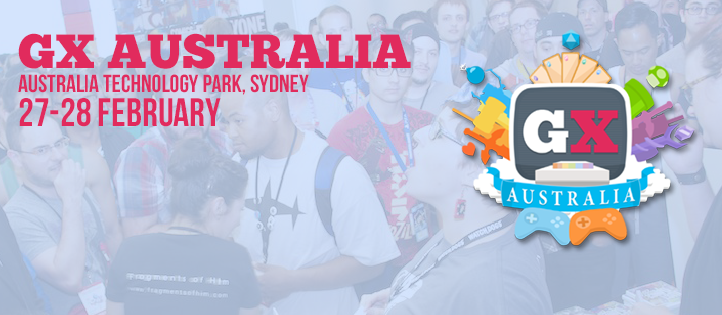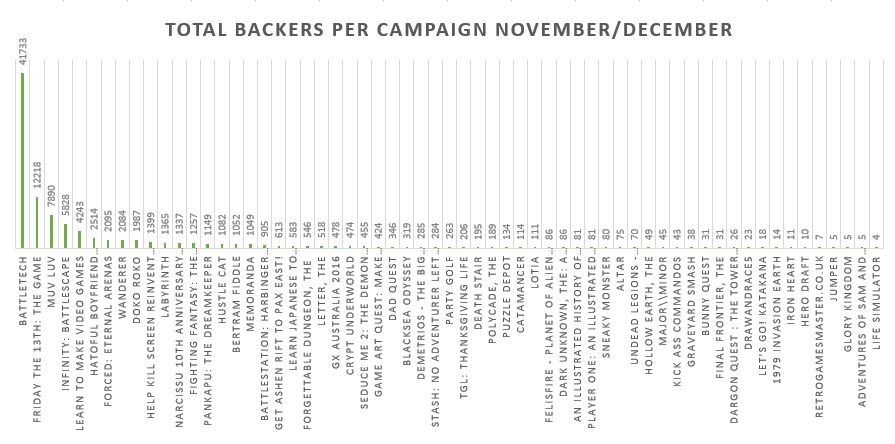Kickstarter is still the best means for most game developers out there to receive crowdfunding support for their projects. As such, we see tons of games come in each and every month looking for their shot at success. When it comes down to it, though, only the best tend to make it through. Well, the best as well as the few projects with a super low goal or the support of friends and family. In the case of November and December, there were a fair amount of successes and we’ll be displaying them together as if they were one mega month instead of running posts for each month separately, as is the norm for us here on Cliqist.
Why is that? Well, aside from the most blatant reason being due to a serious lack of time on my part to publish a November-only series of posts, there is the matter of December itself. Crowdfunding fans have long been aware that things start to dry up in and around December. With less information available in the single month, providing attempts at analysis becomes even more perilous. With all that said, please expect to see monthly analysis posts to be, well, monthly in the future. Information pertaining to each month in particular is still included in some form so it is mostly the graphical depictions which are an amalgamation of both months. Here’s hoping readers will still find enjoyment with this slightly off beat post! Heads up, we’ll also be publishing a 2015 year end Kickstarter analysis post so be on the lookout for that.
Note: All non-US $ amounts have been converted to dollars based on exchange rates as of this writing.

Friday the 13th: The Game (Previous Coverage)
Raised: $823,704 of $700,000 goal
Days to Success: 28
Backers: 12,218
As a tremendous fan of horror movies, it would be impossible for me to go and say I don’t enjoy Friday the 13th. Sure, the series went all over the place over the years, but each entry brought something special to the franchise. It’s for this reason that I was extremely excited to hear that the Friday the 13th game was happening in an official capacity. Not only was it coming, but it looked to be the first “serious” take on the well-known film series since the original game rendition back in the 80s. Some have rightly compared this project to another very similar asymmetrical multiplayer slasher, Last Year, but already Friday the 13th: The Game is proving more fruitful with updates showcasing progress. For those who missed the Kickstarter campaign, there’s now a “Slasher Backer” funding period underway. It’ll last for a few months and so far has raised a little over $20,000 in non-Kickstarter based funds.

GX Australia 2016 (Previous Coverage)
Raised: $55,624 of $36,217 goal
Days to Success: 29
Backers: 478
GX is a convention which desperately needs to continue for the years to come. What makes it different from basically any other gaming convention out there? Simply put, it offers a welcome space for gamers of all gender and sexual identities. Plainly stated: no matter who you are you are welcome to enjoy all that GX has to offer. This is a big deal when many notable gaming events in one form or another cater toward specific “types” of gamers (often unconsciously). After having attended GaymerX2 and GX3, I for one would love to see the convention brought to many more gamers than those who can manage to travel to Northern California. GX Australia 2016 is one way to get Australian gamers in on the GX fun. For a while, I was worried the project had stalled and wouldn’t succeed, but now we know that it’s in the plans for Midboss. Thank goodness!

Hatoful Boyfriend Official Plush Project (Previous Coverage)
Raised: $145,015 of $25,000 goal
Days to Success: 1
Backers: 2,514
Okay, so this Kickstarter campaign wasn’t for a video game but plush toys. Of course, most of us will quickly recognize these stuffed birds as being from the infamous Hatoful Boyfriend visual novel. Although many have never actually played it thanks to the quirky storyline of a human girl attending an all-bird high school, it’s honestly quite good. Those who know the storyline of Hatoful Boyfriend have become something of a highly-devoted fan community. As such, they flew out in force the moment this plush project went live. Seriously. It even raised more than the Hotline Miami figure which Erick Scarecrow previously funded money for. To many, Hotline Miami is more of a typical well-known game than Hatoful Boyfriend is. In any case, thanks to tons of devoted fans (and their hard-earned cash), backers are set to receive a whole plethora of plushies. It’s just a shame that extras won’t be produced! I for one would have loved to get a shot at owning a couple (having decided not to pledge on this Kickstarter in the end).

Raised: $1,255,444 of $250,000 goal
Days to Success: 1
Backers: 7,890
Yep, as a visual novel devotee it’s obvious that Muv-Luv had to appear somewhere on this list of best successes for November and December. I’ll level with you right now: Before word of the upcoming Kickstarter started circulating around the internet, I really had no clue what this whole franchise was even about. There’s mechs, romance, and sci-fi goodness, and that’s all that matters to me! Of course, many out there have been waiting years for an announcement of this sort. With the Kickstarter out there, people pledged immediately and to a tremendous degree. Despite the project not being run by western visual novel publisher powerhouse Sekai Project they still drew immense attention. By the project’s completion, Muv-Luv managed to raise over $1 million, which is far more than any other visual novel to date on Kickstarter. Amazingly, they also appear to be making quick process with the game as well as backer rewards based off their Kickstarter updates.

Seduce Me 2: The Demon War (Previous Coverage)
Raised: $23,333 of $10,000 goal
Days to Success: 1
Backers: 455
Seduce Me was an incredibly positive surprise to me when I finally played through it. This visual novel was successfully funded via Kickstarter thanks to its deliciously unique premise. In this otome title, players would find the protagonist suddenly surrounded by handsome incubi and have her choice as to who she may wish to develop a romance with. Most amazingly, Seduce Me was released as a free download on Steam. I’m sure that this played a large part in how and why the sequel, Seduce Me 2: The Demon War, managed to perform so immensely well on Kickstarter. With existing fans hungry for more incubi action, it only made sense that they’d show up to support a new game in the series. Post-campaign updates have kept people in the loop for what’s to come. Despite a delay from March/April 2016, Michaela Laws has since put a firm release of May 2016. Seduce Me 2 simply can’t come soon enough!

Here we are – the information which folks are always looking to see first up. Exactly how much money was actually raised (toward successful projects)? Between November and December we saw a total of $6,719,643 filter in. That is a tremendous sum of money, and the breakdown between months shows that most of this came thanks to November. November specifically raised $6.2 million of this, while December only contributed $496,310 of it. Why was November so darn profitable? Well, for one, it seems November may be the “last” month of the year that many Kickstarter project leads (and backers themselves) really pay attention to for a year. As such, they’re willing to go all out before December rolls around. Honestly, November kicked the butt out of October which raised $1.8 million while December totally was swept under the rug.
Of course, November had two massive projects in the form of BATTLETECH (which raised $2,785,537) and the aforementioned Muv-Luv (which raised $1,255,444). Friday the 13th: The Game situated itself comfortably into third place with $823,704 in funding by the end on Kickstarter. Did December have any super high performers? Nothing to the level of November, certainly, but the best project reveals just how slow this month was for the site. Hatoful Boyfriend Official Plush Project took first place with $145,015 in funding. Up next was The Polycade with $125,276. Yeeep. Beyond these two, no other campaign was able to raise over $100k before ending in December. If you are planning a Kickstarter for 2016, your takeaway from all this should be to avoid December unless absolutely necessary.
One unfortunate trend these days is people running a project and then cancelling it after being fully funded. I’m still not certain how to handle these annoying campaigns, but as for now they’re counted as part of the successful category. The one successful failure this month was Life Simulator. With a goal of just two dollars, it managed to raise $92 or 4600% of its goal. Of course, a hundred bucks is hardly enough for most anyone to make a game which is probably why they ended up canceling it. In any case, these values are included in the counts for everything this month. The only problematic one is its silly, hyper-inflated inflated success ratio.

Now that we know how much money was raised in total it’s time to turn to the number of projects themselves. November had 38 successes while December saw 23. In total this amounts to 61. Again we see that November was a higher than average amount (as compared to September’s 27 campaigns and October’s 23). However, December fits right in line with these lowered numbers of campaigns. November saw project leads asking for a little over $2.1 million while in December that number had decreased tremendously to $211k. Again, this all jives with the quality and amount of projects per month. October’s set only asked for about $1 million, for reference. All combined, the asking value for both months was $2.3 million. Again, it’s a hefty sum, but November carried the most weight in all.
What about average funding per project? Between December and November the average funding sits at a super healthy $110,158. Of course, as we are now aware, a couple projects were far and away more successful than the rest. Once we remove those million dollar makers from the picture the average funding value dips down to a more sensible (but still really strong) $45,401. October’s average was closer to $48, but that doesn’t mean these past two months both fell beneath it. Taking November averages by themselves (and also removing the same two projects) we get a resulting average funding of $60,621.November, on the other hand, only scrapes by with an average funding value of $21,579. That makes it the worst month in this regard since August’s average of $19,192.
Here’s a part of the crowdfunding scene which I wish didn’t require acknowledging at all. There are tons of fantastic Kickstarters every month, but there are also a tremendous amount of low information projects as well. These have been previously defined by me as campaigns which offer fewer than two images directly related to their project (aka: not clip art or stolen art) as well as more than two paragraphs of text. It shouldn’t be that hard to manage just this — but many pages fail the test! Unfortunately, over November and December 8 projects were deemed low information by myself but still funded. One must assume this is due to direct family/friend involvement because backers are typically savvy enough to avoid such treacherous-looking projects.

I enjoy keeping an eye on exactly how long it takes projects to be funded on Kickstarter. There was a time back in the day where it seemed that everything was funded so fast you could simply sit on the page and watch. These days, we see some Kickstarters with the lucky touch/fanbases which prove the day 1 success story is still totally viable. Most, however, do not have such luck. Amazingly, this section of November and December projects proves the first time that day 1 successes managed to be relatively high with 13 in total. Of course, we’ve also got to pair with it the tremendous amount of projects only being funded in their final weeks and days. With 30 in all only being funded in that time frame, it means nearly half of the campaigns fell into this camp.
November and December both managed to continue the longstanding trend of successful Kickstarters typically receiving funds in the form of U.S. dollars. Of 61 projects, here is the breakdown with regard to currency: USD (37), AUD (8), Pound (7), Euro (5), CAD (4). Although more regions have begun crowdfunding in 2015, many of their currencies (Fr, NOK, SEK) very rarely appear in a successful list. It still appears that developers from non-US regions should still attempt to retrieve funding in the form of USD. While many non-North American campaigns run as USD or CAD, I have still yet to see a campaign from within the U.S. ever seek funding in some other currency (though they may at times set their location to a different country).

Without backers, Kickstarter simply wouldn’t be able to exist. As such, let’s take a look at the backer breakdown for each of the 61 projects which spanned November and December. It should be pretty easy to see that BATTLETECH brought all the backers to their yard with a total of 41,733. Next came Friday the 13th: The Game with a respectable sum of 12,218 backers. Third was Muv-Luv with 7,890. Total backers participating with successful projects across these two months adds up to 98,648. This is huge, though, the breakdown between months easily reveals who the real star performer was. December’s total successful backer count was just 8,045 while November accrued 87,998 of them thanks in large part to a single campaign! For reference, October had closer to 38k while September saw 42k backers. As such, November proves far higher than the recent averages while December had far fewer participants.
Oftentimes, backers find themselves enticed by reward tiers. I personally just find it interesting to view the average reward tiers for three circumstances: the lowest tier, first tier with reward copy of game (when applicable), and highest tier. Of course, this information should be of use to folks planning their own projects as well. The mix of November and December data gives us the following trio of reward tier averages: $4, $44, and $2,647. Whoa, hold on, $44 for a game reward tier? You have to thank The Polycade for that with its $1.5k goal to own your own fancy, spacey looking arcade machine. Okay, so removing that from the picture sets the average to a much more manageable $17. Interestingly, this and the first tier are the same values as they were for October.
There is always more information to generate from Kickstarter video game campaign data, but these are just the most notable tidbits to us. If you’d like to know something else (more specific to one campaign, or other stats) then please let us know in the comments with inquiries and suggestions. We look forward to continue sharing monthly wrap ups throughout the year! You can review analysis and wrap-up articles from previous months using this link.
Here’s a look at each successful campaign in a handy table to get a glimpse at (a small sampling of) the information we gathered to make this post possible:




